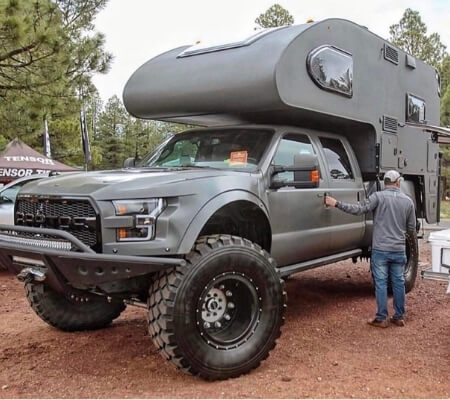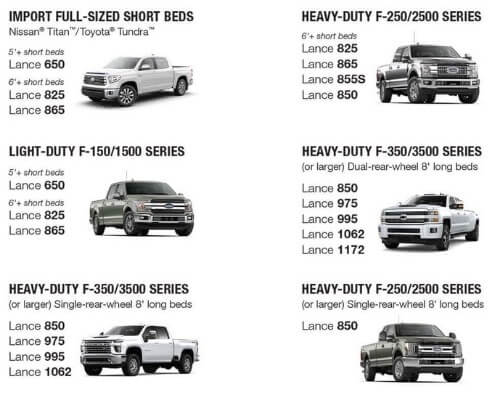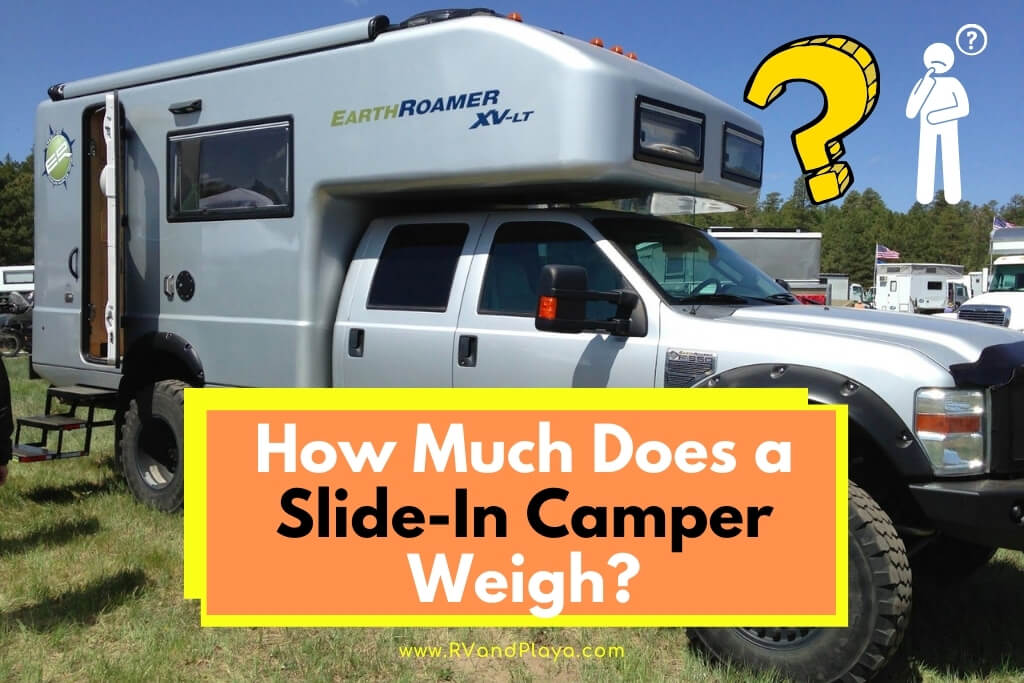It seems like there are countless options for choosing a RV (recreational vehicle) that is best for any given lifestyle. There are style considerations, such as the type of RV, but there are also practical considerations, like the weight of an RV or camper.
The weight of a slide-in camper is especially important to consider when thinking about buying a camper.
How much does a slide-in camper weigh? Slide-in campers themselves generally weigh between 1,000 and 5,000 pounds. This is called the dry weight, which means that it only accounts for the camper and its integral units.
The overall weight of the slide-in camper includes the added elements, like water, luggage, or a water heater, in what is called the wet or real weight.
Even if your truck can hold the dry weight of a camper, you must make sure it can hold the wet weight too.
Luckily, there are many options of slide-in campers that come in different weights, so you can find one that works for your situation.
It is imperative that the truck you use for your slide-in camper is rated for the correct weight, and the following examples can help make sense of what to expect.
Table of Contents
Examples of Slide-In Camper Weights
Before I have a look of how the weight of a slide-in camper is determined, I will look at a few examples to illustrate how slide-in campers commonly weigh.
1. Long-Bed Slide-In Camper: Heavy Example
Naturally, the bigger the camper, the more it usually weighs. This first example camper is the biggest, and it is also the heaviest. This camper is 20’4” in its overall length, with a 9’ exterior height. The dry weight is approximately 4,200 pounds.
The manufacturer estimates a wet weight of approximately 5,200 pounds. That means that an extra one thousand pounds will likely be added to this slide-in camper when it is actually used on a trip.
For this camper, the water tank can hold 42 gallons or 350 pounds of water. It needs two propane tanks for a total of 54 pounds, and the manufacturer estimates that there would be 500 pounds of personal belongings.
The estimates also include 50 pounds for a hot water heater and 130 pounds for batteries
If you think that 500 pounds of personal items is a lot, be sure to consider the space. This is a big camper, so you will likely have a lot of space to fill.
2. Long-Bed Slide-In Camper: Light Example
The camper in this example has a dry weight of approximately 3,350 pounds, an overall length of 19 feet, and an exterior height of 9 feet.
The wet weight estimation adds another 1,100 pounds for an overall wet weight of approximately 4,450 pounds.
Compared to the first example, this camper is the same height with less length, which is why there is such a difference in the dry weight.
The consistency in the height means that this camper can hold up to 45 gallons of water, which is about 375 pounds. This is slightly more than the first camper.
The manufacturer listed the same estimated elements for the weight of the personal belongings, batteries, and a hot water heater.
3. Short-Bed Slide-In Camper: Heavy Example
The dry weight of this short-bed camper is about 3,000 pounds. Its overall length is 18,’ and its exterior height is 8’9”.
The manufacturer estimates that the wet weight would be around 3,950 pounds.
This slide-in camper can hold 250 pounds of water (30 gallons), a 50-pound water heater, two propane tanks for a total of 40 pounds, 130 pounds for two batteries, and the standard 500 pounds for personal items.
4. Short-Bed Slide-In Camper: Light Example
This final example has an overall length of 15’6”, an exterior height of 8’1”, and a dry weight of 1,700 pounds.
This camper is the smallest and lightest example; the low weight is primarily because the camper has a smaller capacity.
With the estimated wet weight elements, this camper would be about 2,450 pounds. That includes about 183.5 pounds of water (22 gallons), 20 pounds for a propane tank, 65 pounds for a battery, and 500 pounds for personal belongings.
You can see the range in slide-in camper weights by looking at this last example in comparison to the first.
The first example is twice as heavy as the last one. That huge difference in weight shows why it is so important to choose the right one.
Understanding Slide In Campers
It is important to understand what type of RV is the focus of this discussion.
Slide-in campers are also sometimes referred to as “truck campers” because they sit on the back of a truck.
What a Slide In Camper Is
Slide-in campers are carried on the beds of trucks, which is why they are said to “slide in.”
This type of camper rests on the pickup truck’s bed, so it is naturally important to make sure that the weight of your slide-in camper is not overbearing on what your truck can carry.

Slide-in campers come in many different styles, which also impacts how much they weigh. Some slide-in campers are designed for short-bed trucks, whereas others are meant to go with long-bed trucks.
Another major aspect to consider with choosing the right slide-in camper is its center of gravity. Ultimately, the slide-in camper’s weight and center of gravity can have significant impacts on the effectiveness and safety of your truck’s performance.
Related reading: 10 Tips and Tricks How to Remove A Slide-Out Out of a Camper
Dry Weight vs. Wet Weight
When you go to buy a slide-in camper, the manufacturer will usually list the camper’s dry weight. This is the weight of just the camper itself, including any built-in elements.
Tip: Sometimes, the labeled dry weight is inaccurate, so you should ask the salesperson to weigh the camper on-site as well.
While the dry weight is an important baseline for understanding how much your slide-in camper weighs, the more important measurement is the wet weight.
This weight takes all the extra elements into account. Everything you put inside the slide-in camper counts as wet weight.
Truck Weight Capacity Ratings
It is the loaded weight of the vehicle (set by the manufacturer) plus the loaded weight of any trailer it tows.
The GVWR, GAWR for the front axle and GAWR for the rear axle are generally posted by the manufacturer on the truck door post or in the glove compartment.

GVWR (Gross Vehicle Weight Rating)
These value represent the loaded weight of a single vehicle.
GAWR (Gross Axle Weight Rating)
These value is the load-carrying capacity of a single axle system. There is a separate (and different) GAWR for the front and rear axles.
CGVWR (Combined Gross Vehicle Weight Rating)
The GVWR, GAWR for the front axle and GAWR for the rear axle are generally posted by the manufacturer on the truck door.
Common Elements of Wet Weight
The exact elements of your slide-in camper’s wet weight may be different from other people’s. Everyone has different things that they need, and these all weigh different amounts.
That being said, there are common elements that will usually go in a slide-in camper.
Water Tank:
Most slide-in campers will have a water tank that needs to be filled. The empty tank should be part of the dry weight for the camper.
To figure out the weight of your filled water tank, you should multiply the number of gallons by 8.34, which is the weight of a gallon of water in pounds.
This means that a water tank that holds 15 gallons will have a water weight of 125.1 pounds.
Personal Belongings:
This is where you can see a lot of variation of the weight of different people’s campers. Two families could start with the same dry weight for the same camper, but their wet weights end up different after their personal belongings are added.
One family might have 200 pounds of personal belongings, such as clothes, sources of entertainment, etc.
The other family might have 400 pounds of similar items, only they have more, or their items are bigger. This all impacts the weight of the slide-in camper.
Propane Tanks:
Most slide-in campers will also have at least one propane tank. Typically, you can estimate that you will need one or two propane tanks that each weigh 20 pounds when full.
Related reading: RV Propane Refill Near Me – Stations & Locations [UPDATED]
The exact amount of propane that your camper needs will vary based on the manufacturer’s specifications.
Sources
https://www.truckcampermagazine.com/buyers-guide/hard-side/lance-camper/
https://www.truckcampermagazine.com/newbie-articles/match-truck-truck-camper/
Recent Posts
Is Toyota Remote Connect Free? (Subscription, Services Plans)
Does Toyota Remote Connect have an included trial? It used to be the case that, when you bought a new car, you made one straightforward payment and that was it. Now, it feels like there are...
Toyota Safety Connect: What It Is And Why You Need It? Whether you’re buying a new Toyota or you’ve had one for a while you will have been given the hard sell on their Connected Services but do...

